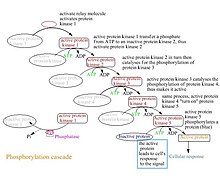|
Phosphorylation cascade
 A phosphorylation cascade is a sequence of signaling pathway events where one enzyme phosphorylates another, causing a chain reaction leading to the phosphorylation of thousands of proteins. This can be seen in signal transduction of hormone messages. A signaling pathway begins at the cell surface where a hormone or protein binds to a receptor at the extracellular matrix. The interactions between the molecule and receptor cause a conformational change at the receptor, which activates multiple enzymes or proteins. These enzymes activate secondary messengers, which leads to the phosphorylation of thousands of proteins. The end product of a phosphorylation cascade is the changes occurring inside the cell. One best example that explains this phenomenon is mitogen-activated protein (MAP) kinase or ERK kinase.[1] MAP kinase not only plays an important function during growth of cell in the M phase phosphorylation cascade but also plays an important role during the sequence of signaling pathway.[2] In order to regulate its functions so it does not cause chaos, it can only be active when both tyrosine and threonine/serine residues are phosphorylated.[3] References
|
Portal di Ensiklopedia Dunia